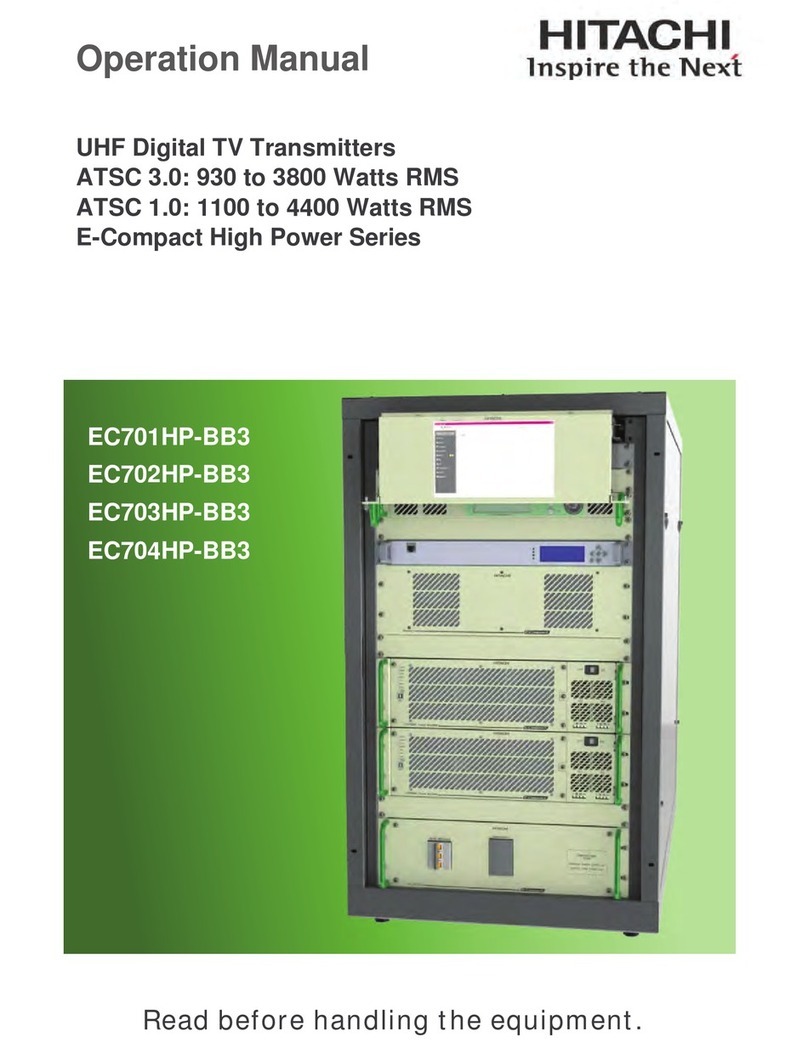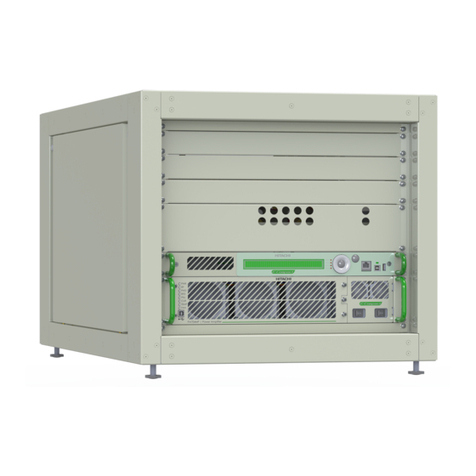
Section 1 - Introduction
Indice
Section 3 - Installation
1.1 Purpose ofthisManual ................................................1-1
1.2 Basic Knowledge Required .........................................1-1
1.3 Structure..................................................................................1-1
1.4 GeneralDescription.....................................................1-2
1.4.1 Transmitter’s Control System ..........................1-3
1.4.2 E-Compact ATSC Transmitters Models...........1-6
1.4.3 Composition.....................................................1-6
1.4.4 Block Diagram of the System...........................1-7
1.4.5 Functional Description of the System..............1-8
1.4.5.1 ATSC Digital Exciter.............................1-8
1.4.5.2 Coaxial Relay (Optional Dual Excitation)
............................................................................... 1-14
3.1
Introduction .......................................................3-1
3.2 Inspection..........................................................3-1
3.3 Installation Recommendations ..........................3-1
3.3.1 PreventiveProtection .............................3-1
3.3.2 Tower..............................................................3-2
3.3.3 Fastening of cables, antennas and
connectors........................................................3-2
3.3.4 Equipment Installation Indoors ..............3-4
3.3.5 Equipment Grounding........................... 3-4
3.3.6 Electric Installation Grounding ...............3-5
3.3.7 PowerSupply.........................................3-5
3.4 Mechanical Drawings ........................................3-6
1.4.5.10 Electrical Distribution Drawer (MCCB)
.............................................................................. 1-19
1.4.5.11 Cooling System...................................1-19
1.5 Technical Specification - E-Compact TV ATSC
Transmitters .....................................................1-20
1.6 Photo - EC702HP Tansmitter................................1-21
Section 2 - Minimum Installation
Requirements
2.1 Introduction..................................................................2-1
2.2 Minimum Requirements...............................................2-1
2.2.1 Electric Power....................................................2-1
2.2.1.1 Grounding .......................................................2-1
2.2.1.2 Stability......................................................................2-1
2.2.1.3 Insulation........................................................2-2
2.2.1.4 WireGage ......................................................2-4
2.3 Atmospheric Discharge Protection System .................2-4
2.3.1 LightningArresters ............................................2-4
2.3.2 CableProtectors................................................2-5
2.4 Air Conditioning............................................................2-5
2.4.1 Temperature...............................................................2-5
2.4.2 Humidity............................................................2-5
2.4.3 Cooling............................................................. 2-6
3.5.2 PowerDrawer.......................................3-14
3.5.3 Rejection Loads Drawer ....................... 3-16
3.5.4 AC UnitPanel........................................ 3-17
3.5.5 TopPanel...............................................3-18
3.6 Power Network Connections............................ 3-19
3.6.1 Power Feeding Options ........................3-19
3.6.2 AC Power Cable Connections.............3-19
3.7 UNPACKING..............................................................3-23
3.8 ONSITE PHYSICALASSEMBLY ..................... 3-33
3.8.1 Assembly Instructions........................... 3-33
3.8.2 Connections ......................................... 3-35
3.8.2.1 Internal Connections.............................3-35
3.8.2.2 External Connections............................3-42
Section 4 - Initial Activation
4.1 Introduction .......................................................4-1
4.2 Connections and Final Checks .........................4-9
4.3 Possible operations with the Transmitter in
Operation ..........................................................4-9
4.3.1 Communication ....................................4-9
4.3.2 Serial terminal Emulators ......................4-10
4.3.3 Forbidden operations.............................4-10
4.3.4 Safeguards .............................................4-10
4.4 Automatic Power reduction Table........................ 4-11
1.4.5.3 Power Splitter .......................................
Front View ............................................. 3-6
1.4.5.4 UHF Power Amplification System ....
Rear View......................................................3-7
1.4.5.5PowerCombiner.................................
Side View.......................................................3-8
1.4.5.6 Loads Bank ..........................................
Dimensions (mm)..................................3-9
1.4.5.7 Filtering System ...................................
Top view with filter........................................3-10
1.4.5.8RF SamplingProbe............................
Panel.......................................................3-11
1.4.5.9PowerSupplies...................................
DigitalExciter.........................................3-11































